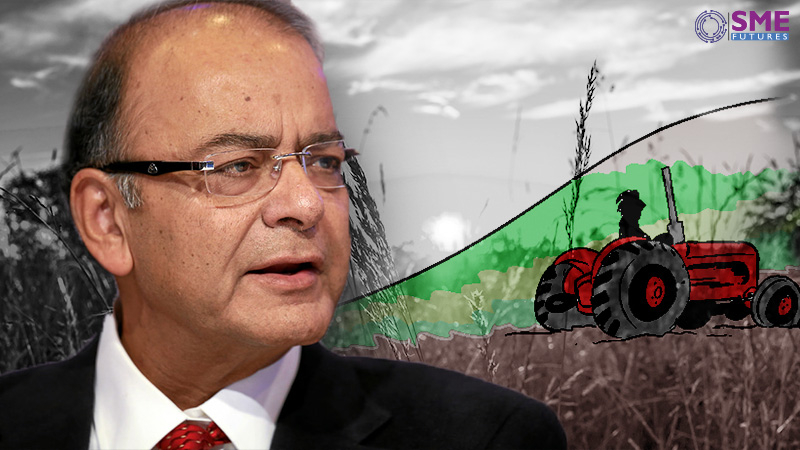The government has acknowledged that a large number of automated teller machines (ATMs) and banks in many parts of the country have run out of cash. But, what it has not acknowledged is the plight of the distressed farmers.
The biggest sufferers of the cash crunch is the agricultural sector. Farmers, the backbone of the national economy, were severely affected by the demonetisation drive of the government, which invalidated 86 per cent of the Indian currency. Now the news of cash crunch in the harvesting season of rabi crops left the sector in omnishambles. “The farmers were still recovering from the impact of demonetisation and now at the beginning of the harvest season, a cash crunch is bad news for the farmers. Let us hope that the government is able to control cash crisis in the next few days,” says Devinder Sharma, an expert on agricultural issues.

As usual crops and spices such as wheat, oats, mustard, cumin, pulses and groundnut have been arriving at agriculture markets in abundance. But farmers, preferring cash as the preferred mode of payment, are shocked to find out that there is no cash in the market for payment.
Agriculture in India accounts for 50 per cent of the country’s workforce, with 58 per cent of the rural households depending on agriculture as their principal means of livelihood. The farmers generally pay their debts and employees after the harvest season. Prior obligations coupled with other factors lead to distressed selling helping middlemen profit of the farmer.
Heavily indebted farmer at times gets spooked by the market forces and resort to selling at a loss. This can also be credited to bad or no infrastructure for storing crops and few government procurement centres. Selling at a loss leads to the vicious cycle where the farmer gets further indebted.
“I have been talking to banking agents and the news on the ground is not great. Andhra Pradesh and Karnataka have been severely hit by the cash crunch. This may lead distress selling, which means farmers will not even get the minimum support price (MSP) on their crops. The farmers might get less than 50 per cent of the sale value. This will further deepen the farmer distress which is already on,” says Vijay Pratap Singh Aditya, founder of Ekgaon Technologies, who runs an e-commerce portal for traditional produce from different parts of the country.

Farmer debt is one of the foremost reasons for farmer suicide in India. A situation like this may lead to more such incidents in the coming months. Punjab, Haryana, Gujarat and Karnataka saw a surge in farmer suicides during 2016 on year-on-year basis. With Gujarat and Karnataka seeing a rise of 35.5 per cent and 32.5 per cent, respectively, 2018 can be a tough year for the farmers there.

The cash woes have come at a time when a fact-finding team of the Swaraj Abhiyan, a political party founded by Yogendra Yadav and Prashant Bhushan, discovered just a month back that farmers were not getting the MSP promised by the government. Its report claimed that not in a single one of the nine mandis in five states that it covered, including Karnataka, Andhra Pradesh and Rajasthan, were farmers able to sell any crop at the government-mandated MSP. The report further states that if farmers continue to be denied MSP, the loss to farmers in rabi season alone could amount to Rs 14,474 crore. But with the dynamic of the cash crunch in the picture, this can become a conservative estimate.
Alok Katare, agriculture trader from Mauranipur in Jhansi, said, “Farmers are not even getting MSP on their produce. For example, chana’s MSP is set at Rs 4,400 per quintal, but is being sold at Rs 3,500.” Talking about the cash crunch, he said, “The wedding season is on, and the farmer expects to be paid in cash, but banks running dry in across cities is a bad news for them, which will lead to lowering of selling price. The business in Budelkhand mandi has been affected since demonetisation and the trader and farmer are both under stress.”
The Central agriculture ministry expects an all-time-high food grain production of 277.5 million tonnes in 2017-18 crop year (July to June) on the good distribution of monsoon rainfall last year. But, untimely rainfall and hailstorms just before the harvests season may impact these numbers.
The government often talks about doubling farm income by 2022. This translates into increasing the average income of a farmer household at current prices to Rs 2,19,724 by 2022-23 from Rs 96,703 in 2015-16, according to Indian Brand Equity Foundation. But, with issues like cash crunch cropping up during the selling season, it seems that the government has set itself a stiff target.











